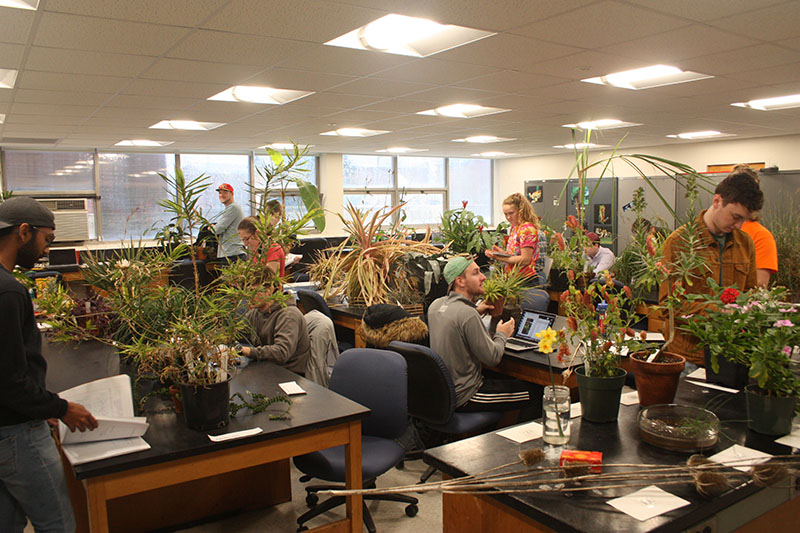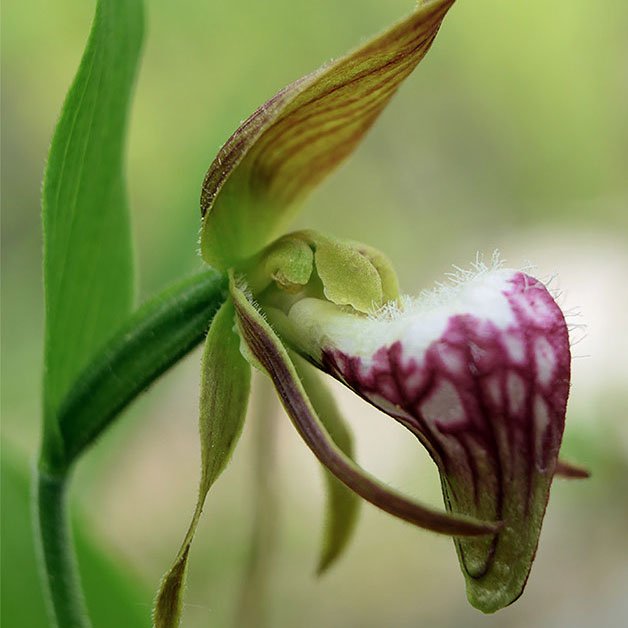 Every other spring, Dr. Les teaches EEB 3271 Systematic Botany, covering the vast diversity of vascular plants. With 3,000 species, the EEB Biodiversity Education & Research Greenhouses enable students to explore global plant diversity and examine diagnostic traits of lineages on living samples from throughout the world. The course relies also on the extensive holdings of preserved plants in the George Safford Torrey Herbarium (CONN). Together these resources provide unique experiential learning opportunities to all students interested in biodiversity and plant evolution.
Every other spring, Dr. Les teaches EEB 3271 Systematic Botany, covering the vast diversity of vascular plants. With 3,000 species, the EEB Biodiversity Education & Research Greenhouses enable students to explore global plant diversity and examine diagnostic traits of lineages on living samples from throughout the world. The course relies also on the extensive holdings of preserved plants in the George Safford Torrey Herbarium (CONN). Together these resources provide unique experiential learning opportunities to all students interested in biodiversity and plant evolution.
Month: April 2019
A Special Orchid Event at UConn
 A special event celebrating Orchids presented by the Department of Ecology & Evolutionary Biology and the Connecticut State Museum of Natural History. Flyer
A special event celebrating Orchids presented by the Department of Ecology & Evolutionary Biology and the Connecticut State Museum of Natural History. Flyer
This event is FREE and open to the public.
When: Saturday, April , 11:00 am – 3:00 pm
Where: Biology/Physics Building Lobby, 91 North Eagleville Road, Storrs, CT 06269
11:00 am – 12:00 noon: Morning Tea with Charles Darwin—Almost Mad About the Wealth of Orchids
UConn Professor Kenneth Noll portrays history’s most famous biologist and naturalist, Charles Darwin. Charles Darwin’s 1862 book Fertilisation of Orchids explores natural theology and the relationship between insects and plants that resulted in their beautiful and complex forms. Tea and scones will be served.
12:00 — 1.30 pm: Between Talks Visit the EEB Greenhouses (and its orchids)
The greenhouses hold the broadest collection of global plant diversity in the Northeast—including over 200 species of orchids, many of which are not commonly grown. Staff will be on hand to guide visitors.
1:30 pm – 2:30 pm: Understanding Orchids with Renowned Author William Cullina
William Cullina, President and CEO, Coastal Maine Botanical Gardens, Boothbay, ME
Orchids are the most diverse, mysterious, and exotic plants in the world. Their popularity as houseplants has surged in recent years as advances in nursery production have made them inexpensive and widely available. Drawing from his award-winning Understanding Orchids, Bill will explore the fascinating, challenging, and deeply rewarding world of orchids. You will never see them the same way again!
florawww.eeb.uconn.edu | CSMNHinfo@uconn.edu
New study enabled by the BRC

The first ordinal phylogenetic study of mosses based on loci from all three genomic compartments was published by Liu et al. Dr. Liu and Medina were former research associates in the Goffinet lab. This study was made possible by the collections held in several herbaria including our CONN collections.
Liu Y., M. G. Johnson, C. J. Cox, R. Medina, N. Devos, A. Vanderpoorten, L. Hedenäs, N. E. Bell, J. R. Shevock, B. Aguero, D. Quandt, N. J. Wickett, A. J. Shaw & B. Goffinet. 2019. Resolution of the backbone phylogeny of mosses using targeted exons from organellar and nuclear genomes. Nature Communications 10: 1485. pdf
Abstract reads: Mosses are a highly diverse lineage of land plants, whose diversification, spanning at least 400 million years, remains phylogenetically ambiguous due to the lack of fossils, massive early extinctions, late radiations, limited morphological variation, and conflicting signal among previously used markers. Here, we present phylogenetic reconstructions based on complete organellar exomes and a comparable set of nuclear genes for this major lineage of land plants. Our analysis of 142 species representing 29 of the 30 moss orders reveals that relative average rates of non-synonymous substitutions in nuclear versus plastid genes are much higher in mosses than in seed plants, consistent with the emerging concept of evolutionary dynamism in mosses. Our results highlight the evolutionary significance of taxa with reduced morphologies, shed light on the relative tempo and mechanisms underlying major cladogenic events, and suggest hypotheses for the relationships and delineation of moss orders.